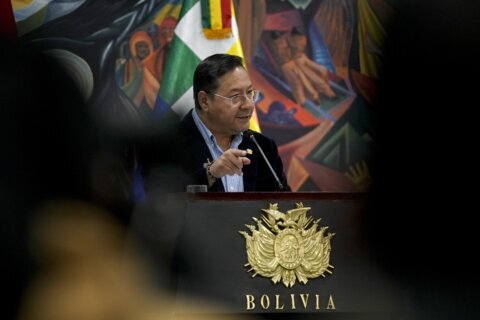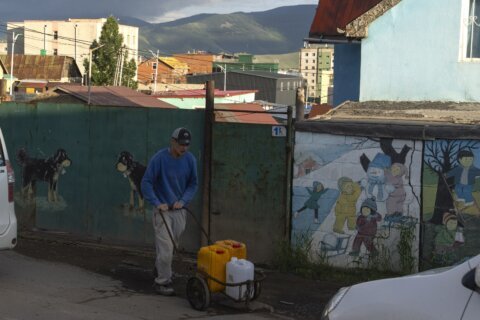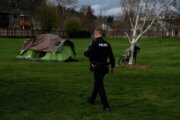TILA, Mexico (AP) — It was night when residents of this remote town began to hear gunshots. Then came the sounds of trucks and the voices of men discussing which houses to burn.
Flames began to leap around Tila, a town of about 10,000 people living along steep streets surrounded by mountains in the southern state of Chiapas. Five hours of shooting were followed by three days of townspeople hiding inside their homes waiting for help.
Their only information came from social media platforms that quickly filled with threatening messages. A video circulated showing a boy standing on a roof waving a white flag at a supposed military helicopter.
Finally, soldiers showed up, and some 5,000 people fled from Tila with what they could carry. It was one of the largest displacements of people in southern Mexico since the 1990s and just the latest example of the security challenges awaiting Mexico’s next president.
Leonel Jiménez, a teacher, spent three days holed up with his mother and 12-year-old brother. Each day he called 911 and received the same answer: They were handling it. Three weeks later they are camped out in a nearby town afraid to return.
“We have leaders who don’t want to do anything,” he said.
Tila is one of many towns in Chiapas where decades-old social conflicts mix with armed groups, political corruption and more recently incursions from organized crime in a vacuum of government authority.
Cartels from the northern states of Sinaloa and Jalisco battle for territory across Mexico and for more than a year have brought that fight to Chiapas along its border with Guatemala. They fight to control lucrative smuggling routes for drugs, migrants and guns.
Some nongovernmental groups in the area say it’s not clear if those powerful cartels are taking advantage of a decades-old conflict over land between Indigenous people and others in Tila, but some see signs of their presence. Others, like a local priest, suggested one town faction could have asked a cartel for help against its rivals. Or someone in the dispute could simply be using the cartels’ fearsome reputation to spread terror as has been seen in other states.
In Tila, most doors and windows remain locked. Dozens of soldiers and police guard the town’s entrances and central plaza. Some residents who fled make quick trips back to gather belongings and leave again.
“You have to leave, because there’s no life” here, a tearful Rafael Gutiérrez said as he emptied his home. He made his living driving Tila’s streets playing ads from a large speaker atop his Volkswagen Beetle, but now says, “We can’t live with this anxiety.”
For more than 60 years, Tila has been divided between the Indigenous peasant farmers who work the surrounding communal lands and those who live in the town and hold title to their property. The farmers believe the town is also communal land, which is the root of the conflict.
The farmers supported the 1994 Zapatista uprising, a brief armed insurgency in Chiapas demanding more rights for Indigenous peoples. Some Tila townspeople allied with paramilitary groups that the government used to try to control the guerrilla fighters after peace accords.
Occasional killings and abuses aimed especially against the farmers have continued over the years.
Things intensified in 2015 when the farmers, whose territorial claim to the town’s land climbed to the Supreme Court, expelled Tila’s elected authorities and imposed communal self-government. The high court still hasn’t made a decision in the land case.
On the outskirts of Tila, the farmers gathered last week to discuss the situation. Farmers, who spoke on condition of anonymity, told The Associated Press that they burned the homes in Tila in the June 4 violence, but said it was a targeted act that followed an attack on one of their communal police patrols. They said the houses burned belonged to people who have allied with the Sinaloa cartel.
“There was shooting because there was no other option,” one farmer said. “We, the legitimate Tila natives, expelled them. Those killers need to get out of here.” He said those targeted were supported by local, state and federal authorities as well as the cartel.
Some of the townspeople who fled Tila contend it is the farmers who brought the cartels into the town’s long-running disputes, accusing them of allying with the Jalisco New Generation cartel. The farmers deny having any ties to the cartel.
President Andrés Manuel López Obrador downplayed the conflict last week, saying it was a local dispute. In May, some Tila residents had asked the president while he was touring Chiapas to intervene, saying they sensed the conflict was about to explode.
That same month, a group of masked people elsewhere in Chiapas stopped the convoy of Claudia Sheinbaum — then a candidate allied with López Obrador and now president-elect — to complain that the government is doing nothing about the area’s security problems.
The Catholic Church is trying to mediate the conflict, opening a dialogue with the factions.
Rev. Alejandro Ornelas, a priest at the Señor de Tila Sanctuary, said he believes organized crime may now be involved with both sides. Without naming them, he said the farmers’ armed group — known as the “Autonomos” — as well as a group from surrounding towns supported by some Tila townspeople — called “Karma” — are both seeking to obtain weapons.
Cartels may be interested in controlling the territory because it connects the southern border with the Gulf of Mexico and the ability to move drugs through there.
Elisabeth Vázquez, who runs a small grocery in front of the church and did not flee, has noted a change. “They shoot all over, (school) classes are inconsistent they come and go on motorcycles and we don’t know who they are,” she said.
What is clear is that the June 4 violence gave credibility to graphic threats that circulated online in the following days to create a mass panic.
Jiménez, the teacher, said that in WhatsApp and Facebook groups there were “death threats, threats to rape women and girls, of forced recruitment” all attributed to the “Autonomos,” the group supported by the farmers.
Six farmers have been arrested in connection with the attack, but those in the Indigenous community say the social media threats had nothing to do with the farmers and call the attribution to “Autonomos” lies. It was misinformation coming from their enemies, they say.
The messages warned that all of Tila was going to burn and audio recordings circulated talking about the powerful .50-caliber guns they would use and saying Jalisco New Generation was joining the fight.
A photo of a murdered family made the rounds. The displaced also shared gruesome, but unconfirmed rumors that a heart was torn out and blood was drunk during the night of mayhem.
While authorities confirmed only that two people — a man and a boy — were killed, in addition to the burning of 17 homes and 21 vehicles, many townspeople believed everything they saw online. So when 500 soldiers appeared three days after the attack and removed the felled trees blocking exits from the town, about half the residents fled.
“When the army arrived, they told us to go because it could get worse,” said Eduardo Pérez, another teacher and father of five. “We evacuated.”
Miguel Ángel Lugo, an employee of the National Electoral Institute, left, too. “We didn’t know what might happen. There were threats that all those who stayed were going to be harmed,” he said.
Authorities are struggling to convince the displaced that it is safe to return to Tila.
Those who fled are demanding a permanent military post be set up in Tila to protect them, something the farmers reject because they don’t trust the army.
“We want them to give us security guarantees,” said Dora María Hernández, an engineer who lived with her family for more than two weeks near the town of Yajalon after fleeing Tila. “The little girl (her daughter) is traumatized. She says she sees armed men in her dreams.”
One man, who sells clothing and repairs motorcycles, said, “I have nowhere to return to.” The man, who spoke on condition of anonymity fearing reprisals, fled with 14 relatives after his house was burned to the ground.
Asked if he was a member of Karma, he said only that he got along with everyone, but added that “if the narcos had arrived this wouldn’t have happened. They would have defended the town.”
Copyright © 2024 The Associated Press. All rights reserved. This material may not be published, broadcast, written or redistributed.







